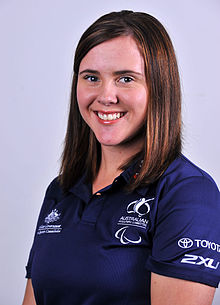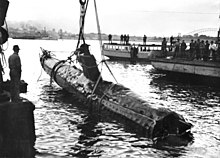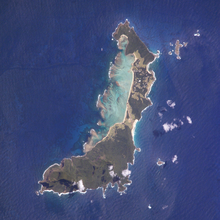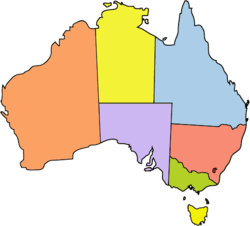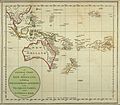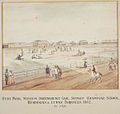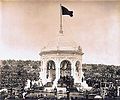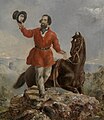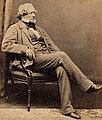Portal:New South Wales
Portal maintenance status: (June 2018)
|
The New South Wales Portal


New South Wales (commonly abbreviated as NSW) is a state on the east coast of Australia. It borders Queensland to the north, Victoria to the south, and South Australia to the west. Its coast borders the Coral and Tasman Seas to the east. The Australian Capital Territory and Jervis Bay Territory are enclaves within the state. New South Wales' state capital is Sydney, which is also Australia's most populous city. In December 2023[update], the population of New South Wales was over 8.3 million, making it Australia's most populous state. Almost two-thirds of the state's population, 5.3 million, live in the Greater Sydney area.
The Colony of New South Wales was founded as a British penal colony in 1788. It originally comprised more than half of the Australian mainland with its western boundary set at 129th meridian east in 1825. The colony then also included the island territories of Van Diemen's Land, Lord Howe Island, and Norfolk Island. During the 19th century, most of the colony's area was detached to form separate British colonies that eventually became the various states and territories of Australia. The Swan River Colony (later called the Colony of Western Australia) was never administered as part of New South Wales. (Full article...)
 Recognized content - load new batch
Recognized content - load new batch 
-
Image 1
The Governor's Body Guard of Light Horse was a military unit maintained in the Colony of New South Wales between 1801 and 1834, and reputedly the "first full-time military unit raised in Australia". It was established by Governor Philip Gidley King by drawing men from the New South Wales Corps, the British garrison in the colony. Normally consisting of one or two non-commissioned officers and six privates, the Guard provided an escort to the governor and carried his despatches to outposts across the colony. From 1802, the men of the Guard were drawn from convicts pardoned by King. Men from the unit were deployed during the Castle Hill convict rebellion of 1804 and a trooper of the Guard assisted in the capture of two of the rebel leaders.
After King was succeeded by William Bligh in 1806, the Guard reverted to being drawn from the New South Wales Corps. The unit seems to have been absent during the Corps' 1808 mutiny against Bligh and, by one report, supported it. It was ordered to disband by the Earl of Liverpool but was granted a reprieve in 1812 by Liverpool's successor Earl Bathurst. Viscount Goderich ordered disbandment again in 1832 and Governor Richard Bourke transformed the unit into the Mounted Orderlies in 1834. These were absorbed into the New South Wales Mounted Police in 1836 and continued as a separate component within that force until at least 1860. (Full article...) -
Image 2St James' Church in about 1890, by Henry King
St James' Church, commonly known as St James', King Street, is an Australian heritage-listed Anglican parish church located at 173 King Street, in the Sydney central business district in New South Wales. Consecrated in February 1824 and named in honour of St James the Great, it became a parish church in 1835. Designed in the style of a Georgian town church by the transported convict architect Francis Greenway during the governorship of Lachlan Macquarie, St James' is part of the historical precinct of Macquarie Street which includes other early colonial era buildings such as the World Heritage listed Hyde Park Barracks.
The church remains historically, socially and architecturally significant. The building is the oldest one extant in Sydney's inner city region. It was added to the New South Wales State Heritage Register on 3 September 2004; and was listed on the (now defunct) Register of the National Estate. (Full article...) -
Image 3Keith Ormond Edley Johnson MBE (28 December 1894 – 19 October 1972), was an Australian cricket administrator. He was the manager of the Australian Services cricket team in England, India and Australia immediately after World War II, and of the Australian team that toured England in 1948. The 1948 Australian cricket team earned the sobriquet The Invincibles by being the first side to complete a tour of England without losing a single match.
Johnson joined the Australian Board of Control for International Cricket in 1935 as a delegate for New South Wales and served in the Royal Australian Air Force during World War II, performing public relations work in London. With the allied victory in Europe, first-class cricket resumed and Johnson was appointed to manage the Australian Services team, which played England in a series of celebratory matches known as the Victory Tests to usher in the post-war era. The series was highly successful, with unprecedented crowds raising large amounts for war charities. As a result, further matches were scheduled and Johnson's men toured British India and Australia before being demobilised. Johnson's administration was regarded as a major factor in the success of the tour. (Full article...) -
Image 4
Hannah Dodd (born 27 April 1992) is an Australian Grade IV equestrian and 1.0 point wheelchair basketball player who represented Australia in equestrian at the 2012 Summer Paralympics in London, coming 11th and 12th in her events. Switching to wheelchair basketball, she made her debut with the national team at the Osaka Cup in February 2015.
In 2008, Dodd was the Australian national Grade IV para-equestrian champion. She was runner-up in 2009, and won the Australian national championships again in 2011, along with the Oceania Championships and the National Titles team events. By 2012, she was the top-ranked Australian competitor in her event and class. (Full article...) -
Image 5The Point Stephens Light is a heritage-listed active lighthouse located on Point Stephens, a point on an unnamed headland at the east of Fingal Bay, 4.25 km (2.64 mi) south of the entrance of Port Stephens, New South Wales, Australia. The light serves to assist vessels entering Port Stephens. It is considered an endangered lighthouse due to remote location and old age.
Proposed in 1857, the heritage-listed lighthouse was built in 1862. Designed by Alexander Dawson, the New South Wales Government Architect at that time, both the lighthouse's flared base and the keeper's cottages combined terrace are unique architectural features for the period. The light source used was originally kerosene lamps, which upgraded in 1912 to a Dalén light, upgraded again to electric light in 1960, automated in 1973, and finally converted to solar power in 1990. In 1991, the last caretaker withdrew from the premises and very soon after the keeper's cottages were vandalised and burned. (Full article...) -
Image 6A Japanese Ko-hyoteki class midget submarine, believed to be midget No. 14, is raised from Sydney Harbour the day after the attack.
From 31 May to 8 June 1942, during World War II, Imperial Japanese Navy submarines made a series of attacks on the Australian cities of Sydney and Newcastle. On the night of 31 May – 1 June, three Ko-hyoteki-class midget submarines, (M-14, M-21 and M-24) each with a two-member crew, entered Sydney Harbour, avoided the partially constructed Sydney Harbour anti-submarine boom net, and attempted to sink Allied warships. Two of the midget submarines were detected and attacked before they could engage any Allied vessels. The crew of M-14 scuttled their submarine, whilst M-21 was successfully attacked and sunk. The crew of M-21 killed themselves. These submarines were later recovered by the Allies. The third submarine attempted to torpedo the heavy cruiser USS Chicago, but instead sank the converted ferry HMAS Kuttabul, killing 21 sailors. This midget submarine's fate was unknown until 2006, when amateur scuba divers discovered the wreck off Sydney's northern beaches.
Immediately following the raid, the five Japanese fleet submarines that carried the midget submarines to Australia embarked on a campaign to disrupt merchant shipping in eastern Australian waters. Over the next month, the submarines attacked at least seven merchant vessels, sinking three ships and killing 50 sailors. During this period, between midnight and 02:30 on 8 June, two of the submarines bombarded the ports of Sydney and Newcastle. (Full article...) -
Image 7
Aleeta is a genus of cicadas with the only species Aleeta curvicosta (commonly known as the floury baker or floury miller, known until 2003 as Abricta curvicosta), one of Australia's most familiar insects. Native to the continent's eastern coastline, it was described in 1834 by Ernst Friedrich Germar.
The floury baker's distinctive appearance and loud call make it popular with children. Both the common and genus name are derived from the white, flour-like filaments covering the adult body. Its body and eyes are generally brown with pale patterns including a light-coloured line along the midline of the pronotum. Its forewings have distinctive dark brown patches at the base of two of their apical cells. The female is larger than the male, although species size overall varies geographically, with larger animals associated with regions of higher rainfall. The male has distinctive genitalia and a loud and complex call generated by the frequent buckling of ribbed tymbals and amplified by abdominal air sacs. (Full article...) -
Image 8

Alloxylon pinnatum, known as Dorrigo waratah, is a tree of the family Proteaceae found in warm-temperate rainforest of south-east Queensland and northern New South Wales in eastern Australia. It has shiny green leaves that are either pinnate (lobed) and up to 30 cm (12 in) long, or lanceolate (spear-shaped) and up to 15 cm (5.9 in) long. The prominent pinkish-red flower heads, known as inflorescences, appear in spring and summer; these are made up of 50 to 140 individual flowers arranged in corymb or raceme. These are followed by rectangular woody seed pods, which bear two rows of winged seeds.
Known for many years as Oreocallis pinnata, it was transferred to the new genus Alloxylon by Peter Weston and Mike Crisp in 1991. This genus contains the four species previously classified in Oreocallis that are found in Australasia. Its terminal globular flowers indicate that the species is pollinated by birds. Classified as near threatened under the Queensland Nature Conservation Act 1992, the Dorrigo waratah has proven difficult to keep alive in cultivation. (Full article...) -
Image 9
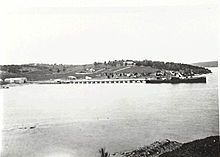
Illawarra Steam Navigation Company's SS Bega at Eden in 1903.
The Illawarra Steam Navigation Company was a shipping company that serviced the south coast of New South Wales, Australia from 1858 to the early 1950s. It was formed through the amalgamation of the General Steam Navigation Company, the Kiama Steam Navigation Company and the Shoalhaven Steam Navigation Company, each of whom serviced parts of the south coast with their respective vessels. After merging, the new company held a near monopoly in regard to shipping on the south coast, and their fleet visited every significant port between Sydney and the border of Victoria. The company transported both passengers and a range of produce, including livestock, and hence it became known as the 'Pig and Whistle Line': it was said that ships would wait an hour for a pig but not a minute for a passenger.
Over the years more than twenty steamships were a part of the fleet, including the 1112-ton Merimbula and the 693-ton Eden. Many of these vessels were purpose-built for the company's needs, and were constructed at shipyards both within Australia and abroad. The company's eventual demise came as a result of a number of factors, including increased competition from road and rail, the cost of replacing ships after World War II, waterfront disputes and rising costs. As a consequence, after almost 100 years in operation, the company was placed into voluntary receivership and was delisted from the stock exchange in 1955. (Full article...) -
Image 10The Murrumbidgee River at Wagga Wagga
The Riverina (/ˌrɪvəˈriːnə/)
is an agricultural region of southwestern New South Wales, Australia. The Riverina is distinguished from other Australian regions by the combination of flat plains, warm to hot climate and an ample supply of water for irrigation. This combination has allowed the Riverina to develop into one of the most productive and agriculturally diverse areas of Australia. Bordered on the south by the state of Victoria and on the east by the Great Dividing Range, the Riverina covers those areas of New South Wales in the Murray and Murrumbidgee drainage zones to their confluence in the west.
Home to Aboriginal groups including the Wiradjuri people for over 40,000 years, the Riverina was colonised by Europeans in the mid-19th century as a pastoral region providing beef and wool to markets in Australia and beyond. In the 20th century, the development of major irrigation areas in the Murray and Murrumbidgee valleys has led to the introduction of crops such as rice and wine grapes. The Riverina has strong cultural ties to Victoria, and the region was the source of much of the impetus behind the federation of Australian colonies. (Full article...) -
Image 11HMCS Integrity was a cutter built by the Colonial Government of New South Wales in 1804. She was the first vessel ever launched from a New South Wales dockyard and carried goods between the colony's coastal settlements of Norfolk Island, Newcastle, New South Wales, Van Diemen's Land and Port Jackson. In 1804 she took part in a series of voyages to Van Diemen's Land with the aim of founding a colony at Port Dalrymple, the site of the modern settlement of George Town, Tasmania.
In 1805 Integrity encountered and recaptured a Spanish brig which had been unlawfully seized by privateers and concealed in the Kent Group of islands in Bass Strait. Having returned the Spanish vessel to colonial control, Integrity was designated the task of sailing to Chile to negotiate its return to Spain. She set sail for Valparaíso, Chile, in June 1805, but was not seen again and is likely to have foundered during the voyage. (Full article...) -
Image 12
Lord Howe Island (/haʊ/; formerly Lord Howe's Island; Norfuk: Lord Howe Ailen) is an irregularly crescent-shaped volcanic remnant in the Tasman Sea between Australia and New Zealand, part of the Australian state of New South Wales. It lies 600 km (370 mi; 320 nmi) directly east of mainland Port Macquarie, 780 km (480 mi; 420 nmi) northeast of Sydney, and about 900 km (560 mi; 490 nmi) southwest of Norfolk Island. It is about 10 km (6.2 mi) long and between 0.3 and 2.0 km (0.19 and 1.24 mi) wide with an area of 14.55 km2 (3,600 acres), though just 3.98 km2 (980 acres) of that comprise the low-lying developed part of the island. The island is named after Richard Howe, 1st Earl Howe.
Along the west coast is a sandy semi-enclosed sheltered coral reef lagoon. Most of the population lives in the north, while the south is dominated by forested hills rising to the highest point on the island, Mount Gower (875 m, 2,871 ft). The Lord Howe Island Group comprises 28 islands, islets, and rocks. Apart from Lord Howe Island itself, the most notable of these is the volcanic and uninhabited Ball's Pyramid about 23 km (14 mi; 12 nmi) to the southeast of Howe. To the north lies the Admiralty Group, a cluster of seven uninhabited islets. (Full article...) -
Image 13Norah Head Light is an active lighthouse located at Norah Head, a headland on the Central Coast, New South Wales, Australia, close to Toukley. It is the last lighthouse of the James Barnet style to be built, and the last staffed lighthouse constructed in New South Wales.
Officially displayed for the first time in 1903, the original vaporized kerosene burner was upgraded in 1923, electrified in 1961 and automated and demanned in 1994, after more than 90 years of being staffed. It celebrated its centenary in 2003. (Full article...) -
Image 14
Maddison Gae Elliott, OAM (born 3 November 1998) is an Australian swimmer. At the 2012 Summer Paralympics in London, she became the youngest Australian Paralympic medallist by winning bronze medals in the women's 400 m and 100 m freestyle S8 events. She then became the youngest Australian gold medallist when she was a member of the women's 4 × 100 m freestyle relay 34 points team. At the 2016 Rio Paralympics, she won three gold and two silver medals. (Full article...) -
Image 15
John Cash Neild (4 January 1846 – 8 March 1911) was an Australian politician who served as a Senator from New South Wales from 1901 to 1910.
Neild's family arrived in Australia in 1860, and he worked as an insurance agent and company manager before winning election to the New South Wales Legislative Assembly in 1885. He served intermittently until 1901 and had a tumultuous career as a backbencher, eventually contributing significantly to the fall of the Reid government in 1899. He also established his own volunteer regiment, which had a difficult and sometimes hostile relationship with military command. (Full article...)
Selected image

| Credit: Adam J.W.C. |
The Sydney Opera House is situated on Bennelong Point in Sydney Harbour, close to the Sydney Harbour Bridge. It is one of the world's most distinctive 20th century buildings, and one of its most famous performing arts venues. It was made a UNESCO World Heritage Site on June 28, 2007.
Related portals
WikiProjects
Selected articles - load new batch
-
Image 11959 Sulman Medal
Australian Academy of Science
The Sir John Sulman Medal for Public Architecture is an architectural award presented by the New South Wales chapter of the Australian Institute of Architects since 1932. The medal is sometimes referred to as the Sulman Award and now recognises excellence in public buildings in either New South Wales or in the Australian Capital Territory. Before the advent of the Wilkinson Award in 1961, it was on occasion presented to residential housing projects.
The medal is presented in memory of the Australian architect Sir John Sulman (29 August 1849 – 18 August 1934). Sulman was born in Greenwich, England, and emigrated to Sydney in 1885. From 1921 to 1924 he was chairman of the Federal Capital Advisory Committee and influenced the development of Canberra. The medal was designed by George Rayner Hoff (1894—1937), sculptor and teacher, famed for his sculptures in Sydney's Anzac Memorial. (Full article...) -
Image 2
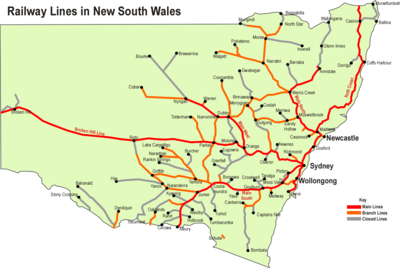
Map of rail lines in NSW
The Australian state of New South Wales has an extensive network of railways, which were integral to the growth and development of the state. The vast majority of railway lines were government built and operated, but there were also several private railways, some of which operate to this day. (Full article...) -
Image 3
The New South Wales Police Force is a law enforcement agency of the state of New South Wales, Australia, established in 1862. With more than 17,000 police officers, it is the largest police organisation in Australia, policing an area of 801,600 square kilometres with a population of more than 8.2 million people.
In 2020, it had 21,455 employees – 17,348 police officers and 4,107 support staff, 432 police stations, 3,300 vehicles, 52 boats, 9 aircraft and a budget of AUD $4.8 billion. It is organised into police area commands (PACs) in metropolitan areas, police districts (PDs) in rural areas and specialist commands. (Full article...) -
Image 4
Smoky Cape Lighthouse is a heritage-listed active lighthouse located on Smoky Cape, a headland in Arakoon east of the town of South West Rocks, Kempsey Shire, New South Wales, Australia, and within the Hat Head National Park. It directs boats towards the entrance to the Macleay River, which is located just to the north of the lighthouse.
It is one of the last major lighthouse complexes designed by the New South Wales colonial architect of the time, James Barnet, and was one of Australia's last lighthouses to be designed for architectural excellence.
Standing on a granite headland 111 metres (364 ft) above the sea, its light is the highest in New South Wales. (Full article...) -
Image 5Aerial photograph showing the mouth of the Hawkesbury River as it flows into Broken Bay and out into the Tasman Sea, as seen looking across Sydney's Northern Beaches
The Hawkesbury River, or Hawkesbury-Nepean River (Dharug: Dyarubbin) a river located northwest of Sydney, New South Wales, Australia. The Hawkesbury River and its associated main tributary, the Nepean River, almost encircle the metropolitan region of Sydney. The river between Wisemans Ferry and the Pacific Ocean marks the boundary of Greater Metropolitan Sydney in the south and the Central Coast region to the north.
The Hawkesbury River has its origin at the confluence of the Nepean River and the Grose River, to the north of Penrith and travels for approximately 120 kilometres (75 mi) in a north–easterly and then a south–easterly direction to its mouth at Broken Bay, about 15 kilometres (9.3 mi) from the Tasman Sea. The Hawkesbury River is the main tributary of Broken Bay. Secondary tributaries include Brisbane Water and Pittwater, which, together with the Hawkesbury River, flow into Broken Bay and thence into the Tasman Sea north of Barrenjoey Head. (Full article...) -
Image 6
Sydney is the capital city of the state of New South Wales and the most populous city in Australia. Located on Australia's east coast, the metropolis surrounds Sydney Harbour and extends about 80 km (50 mi) from the Pacific Ocean in the east to the Blue Mountains in the west, and about 80 km (50 mi) from the Ku-ring-gai Chase National Park and the Hawkesbury River in the north and north-west, to the Royal National Park and Macarthur in the south and south-west. Greater Sydney consists of 658 suburbs, spread across 33 local government areas. Residents of the city are colloquially known as "Sydneysiders". The estimated population in June 2023 was 5,450,496, which is about 66% of the state's population. The city's nicknames include the Emerald City and the Harbour City.
Aboriginal Australians have inhabited the Greater Sydney region for at least 30,000 years, and their engravings and cultural sites are common. The traditional custodians of the land on which modern Sydney stands are the clans of the Darug, Dharawal and Eora peoples. During his first Pacific voyage in 1770, James Cook charted the eastern coast of Australia, making landfall at Botany Bay. In 1788, the First Fleet of convicts, led by Arthur Phillip, founded Sydney as a British penal colony, the first European settlement in Australia. After World War II, Sydney experienced mass migration and by 2021 over 40 per cent of the population was born overseas. Foreign countries of birth with the greatest representation are mainland China, India, the United Kingdom, Vietnam and the Philippines. (Full article...) -
Image 7
The Bank of New South Wales (BNSW), also known as The Wales, was the first bank in Australia. It was established in 1817 in Sydney. During the 19th century, the bank opened branches throughout Australia and New Zealand, expanding into Oceania in the 20th century. Throughout it history it merged with and purchased many other financial institutions. In 1981 it merged with the Commercial Bank of Australia and was renamed Westpac on 4 May 1982. (Full article...) -
Image 8From top, left to right: Maitland Court House, The Levee, Maitland Post Office, St Mary's the Virgin Anglican Church, Citizens Memorial at Maitland Park
Maitland (/ˈmeɪtlənd/) is a city in the Hunter Valley of New South Wales, Australia and the seat of Maitland City Council, situated on the Hunter River approximately 166 kilometres (103 mi) by road north of Sydney and 35 km (22 mi) north-west of Newcastle. It is on the New England Highway approximately 17 km (11 mi) from its origin at Hexham.
At the 2021 census it had approximately 89,597 inhabitants, spread over an area of 392 square kilometres (151 sq mi), with most of the population located in a strip along the New England Highway between the suburbs of Lochinvar and Thornton respectively. The city centre is located on the right bank of the Hunter River, protected from moderate potential flooding by a levee. (Full article...) -
Image 9
Taronga Zoo is a government-run public zoo located in Sydney, New South Wales, Australia, in the suburb of Mosman, on the shores of Sydney Harbour. The opening hours are between 9:30 a.m. to 4:30 p.m. (May to August) and 9:30 am to 5:00 pm (September to April). Taronga is an Aboriginal word meaning "beautiful view".
It was officially opened on 7 October 1916. Taronga Zoo Sydney is managed by the Zoological Parks Board of New South Wales, under the trading name Taronga Conservation Society, along with its sister zoo, the Taronga Western Plains Zoo in Dubbo. (Full article...) -
Image 10
The Supreme Court of New South Wales is the highest state court of the Australian State of New South Wales. It has unlimited jurisdiction within the state in civil matters, and hears the most serious criminal matters. Whilst the Supreme Court is the highest New South Wales court in the Australian court hierarchy, an appeal by special leave can be made to the High Court of Australia.
Matters of appeal can be submitted to the New South Wales Court of Appeal and Court of Criminal Appeal, both of which are constituted by members of the Supreme Court, in the case of the Court of Appeal from those who have been commissioned as judges of appeal. (Full article...) -
Image 11View of Mount Duval with farms in the foreground
New England is a geographical region in the north of the state of New South Wales, Australia, about 60 km (37 mi) inland from the Tasman Sea. The area includes the Northern Tablelands (or New England Tablelands) and the North West Slopes regions. As of 2021, New England had a population of 185,560, with over a quarter of the people living in the area of Tamworth Regional Council. (Full article...) -
Image 12

Sydney Kingsford Smith Airport (IATA: SYD, ICAO: YSSY) — colloquially Mascot Airport, Kingsford Smith Airport, or Sydney Airport — is an international airport serving Sydney, New South Wales, Australia, 8 km (5.0 mi) south of the Sydney central business district, in the suburb of Mascot. Sydney Airport is the busiest airport in Oceania. It is the primary airport serving Sydney and is a primary hub for Qantas, as well as a secondary hub for Virgin Australia and Jetstar.
Situated next to Botany Bay on 907 hectares (2,241 acres) of land with three runways, Sydney Airport is one of the world's longest continuously operated commercial airports and is the busiest airport in Australia, handling 42.6 million passengers and 348,904 aircraft movements in 2016–17. It was the 48th busiest airport in the world in 2022. Currently, 46 domestic and 43 international destinations are served to Sydney directly. In 2018, the airport was rated in the top five worldwide for airports handling 40–50 million passengers annually and was overall voted the 20th best airport in the world at the Skytrax World Airport Awards. (Full article...) -
Image 13
The Lamington National Park is a national park in the McPherson Range on the Queensland/New South Wales border in Australia. From Southport on the Gold Coast the park is 85 kilometres (53 mi) to the southwest and Brisbane is 110 kilometres (68 mi) north. The 20,600 hectares (51,000 acres) Lamington National Park is known for its natural environment, rainforests, birdlife, ancient trees, waterfalls, walking tracks and mountain views. The park protects parts of the Eastern Australian temperate forests.
Protected areas to the east in Springbrook National Park and south along the Tweed Range in the Border Ranges National Park around Mount Warning in New South Wales conserve similar landscapes. The park is part of the Shield Volcano Group of the World Heritage Site Gondwana Rainforests of Australia inscribed in 1986 and added to the Australian National Heritage List in 2007. The park is part of the Scenic Rim Important Bird Area, identified as such by BirdLife International because of its importance in the conservation of several species of threatened birds. (Full article...) -
Image 14
Kristina Marie Kerscher Keneally (born 19 December 1968) is an American-born Australian politician who served as the first female Premier of New South Wales from 2009 to 2011 and was later a Labor Senator for New South Wales from February 2018 until April 2022. She resigned from the Senate to contest the House of Representatives seat of Fowler, but was unsuccessful. From 2019 to 2022 she served as Deputy Leader of the Opposition in the Senate, Shadow Minister for Home Affairs, and Shadow Minister for Immigration and Citizenship.
Keneally was born in the United States to an American father and an Australian mother. She grew up in Toledo, Ohio, and is a graduate of the University of Dayton. After marrying an Australian, Ben Keneally, she settled in Australia permanently and became a naturalised citizen in 2000. Keneally was elected to the New South Wales Legislative Assembly seat of Heffron at the 2003 state election, succeeding Deirdre Grusovin after a controversial preselection process. After being re-elected to parliament at the 2007 state election, she became the Minister for Ageing and Disability Services and was subsequently appointed Minister for Planning by Premier Nathan Rees in 2008. She was also the state government's spokeswoman for World Youth Day 2008. (Full article...) -
Image 15Sport in New South Wales describes participation in and attendance at organised sports events in the state of New South Wales in Australia. Sport forms an integral part of the culture of the state.
New South Wales has attracted many international multi-sport events including the 2000 Summer Olympics, held in Sydney. There are many professional sporting teams in New South Wales. The biggest sport in the state by a wide margin is rugby league, in which the state has 10 professional clubs in the National Rugby League. Other popular spectator sports include rugby union, cricket, Australian rules football and soccer. In terms of participation, the most popular sports in the state are netball, tennis, soccer, rugby league and touch football. (Full article...)
Did you know (auto-generated)

- ... that in its two years of existence, the Hunter River Railway Company initiated construction on what would eventually become the Great Northern Railway connecting Sydney to Queensland?
- ... that many an Xplorer has traversed the rails in Canberra?
- ... that Turkish international soccer player Rojin Polat was named member of the "2021 All Schools Merit Girls Team" in New South Wales, Australia?
- ... that the rural village of Neath, New South Wales, had a population of three Tok Pisin speakers in 2021?
General images - load new batch
-
Image 1Dry paddocks in the Riverina region during the 2007 drought (from History of New South Wales)
-
Image 2Olympic colours on the Sydney Harbour Bridge in the year 2000 (from History of New South Wales)
-
Image 3A General Chart of New Holland including New South Wales & Botany Bay with The Adjacent Countries and New Discovered Lands, published in An Historical Narrative of the Discovery of New Holland and New South Wales, London, Fielding and Stockdale, November 1786 (from History of New South Wales)
-
Image 6The 5th Governor of New South Wales, Lachlan Macquarie, was influential in establishing civil society in Australia (from History of New South Wales)
-
Image 7Humanitarian Caroline Chisholm provided support to poverty-stricken women migrants (from History of New South Wales)
-
Image 8Japanese POW camp at Cowra, shortly before the Cowra breakout (from History of New South Wales)
-
Image 9A chart of part of the interior of New South Wales by John Oxley, Surveyor General, 1822 (from History of New South Wales)
-
Image 11Hyde Park, Sydney with the Australian Museum under construction in the distance, 1842 (from History of New South Wales)
-
Image 12A bulk carrier entering the Port of Newcastle, New South Wales, 2009 (from Economy of New South Wales)
-
Image 13Tumut 3 Power Station was constructed as part of the vast Snowy Mountains Scheme in New South Wales (1949–1974). Construction necessitated the expansion of Australia's immigration program. (from History of New South Wales)
-
Image 14Landing of Lieutenant James Cook at Botany Bay, 29 April 1770, by E. Phillips Fox (from History of New South Wales)
-
Image 16The New South Wales Parliament is Australia's oldest parliament. (from History of New South Wales)
-
Image 17Founding of the settlement of Port Jackson at Botany Bay in New South Wales in 1788, by Thomas Gosse (from History of New South Wales)
-
Image 19Ribbon ceremony to open the Sydney Harbour Bridge on 20 March 1932. Breaking protocol, the soon to be dismissed Premier Jack Lang cuts the ribbon while Governor Philip Game looks on. (from History of New South Wales)
-
Image 20Federation Pavilion, Centennial Park, Sydney, 1 January 1901. (from History of New South Wales)
-
Image 21World leaders with Prime Minister John Howard in Sydney for the 2007 APEC conference (from History of New South Wales)
-
Image 24Mr E.H. Hargraves, The Gold Discoverer of Australia, returning the salute of the gold miners - Thomas Tyrwhitt Balcombe, 1851 (from History of New South Wales)
-
Image 25William Wentworth was key in the establishment of self-governance in New South Wales (from History of New South Wales)
Topics
Categories
More portals
In the news
- 5 January 2025 – 2025 United Cup
- In tennis, the United States wins its second United Cup title after defeating Poland 2–0 in the final at the Ken Rosewall Arena in Sydney, Australia. (Reuters)
- 23 December 2024 –
- A man is arrested and charged with animal cruelty for shooting and killing 98 kangaroos on a military base in Singleton, New South Wales, Australia. (news.com.au)
Associated Wikimedia
The following Wikimedia Foundation sister projects provide more on this subject:
-
Commons
Free media repository -
Wikibooks
Free textbooks and manuals -
Wikidata
Free knowledge base -
Wikinews
Free-content news -
Wikiquote
Collection of quotations -
Wikisource
Free-content library -
Wikiversity
Free learning tools -
Wikivoyage
Free travel guide -
Wiktionary
Dictionary and thesaurus




